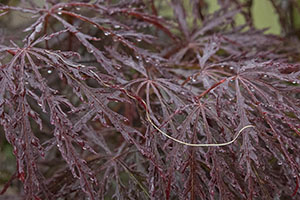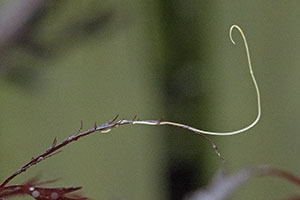
| The Nematodes form a phylum with some 25,000 described species - though undoubtedly this is a gross underestimate of the real number. Most free-living species are microscopically small, but parasitic species can be much larger, up to 8 m! The Nematode shown below belongs to the family Mermithidae. Most likely, these worms are females laying eggs. The eggs remain attached to the leaves, so that if these leaves are eaten by for instance a grasshopper, the eggs are ingested, too. They hatch inside the insect host and develop till the last larval stage, after which they come out of the insect, causing its death. After leaving the insect, the Nematode no longer feeds and relies fully on stored food. The last-stage larva goes into the soil and molds to the adult stage. Source: Nickle, W.R. 1972. A contribution to our knowledge of the Mermithidae (Nematoda). Journal of Nematology 4: 113 - 146. |



